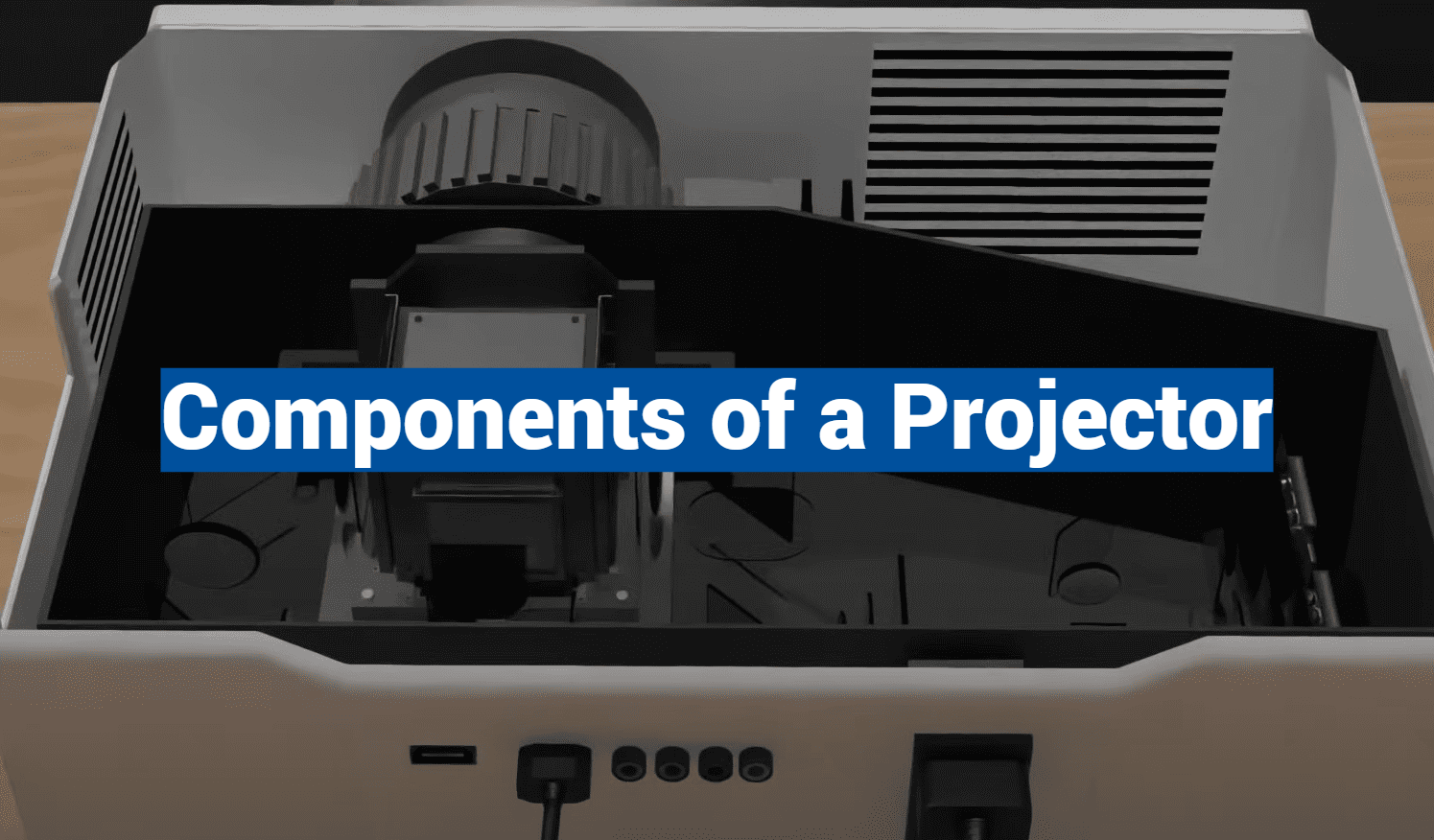Projectors have become key equipment in business conferences, classrooms, and home theaters, offering larger-than-life visuals and aiding in effective communication. This article aims to familiarize readers with the foundational components of a projector, delving into the functionalities and significance of each part.
Light Source
The light source is the heart of a projector, responsible for creating the image that is projected onto the screen. Traditional projectors make use of halogen lamps, which produce bright and vibrant colors but need frequent replacement and are energy inefficient. Nowadays, most projectors use LEDs or laser bulbs as their light source, offering better color accuracy, longer lifespan, and lower power consumption.

Optics
The optics of a projector refer to the lens system that projects the light from the source onto the screen. The type of lens used varies depending on the projector’s purpose and design. Short-throw projectors, for example, have wide-angle lenses that can project large images even in small spaces. High-end projectors may also feature zoom lenses, allowing for adjustable image sizes without moving the projector itself. [1]
Imaging Device
The imaging device is responsible for processing and displaying the light from the source onto the screen. Over the years, there have been various types of imaging devices used in projectors, including CRT tubes, LCD panels, and DLP chips. Today, most projectors use either LCD or DLP technology, with DLP being the more popular choice due to its higher contrast and better color accuracy.
Color Wheel
Some projectors, especially those using DLP technology, also come equipped with a color wheel. The color wheel is a rotating disc that contains red, green, and blue filters. As it spins, the colors are projected in sequence onto the screen, creating the illusion of a full-color image. The speed at which the color wheel rotates determines the refresh rate of colors and can impact the overall quality of the projected image.
Cooling System
Due to the high intensity of light produced by projectors, they require an efficient cooling system to prevent overheating. Most projectors come equipped with fans that circulate cool air and dissipate the heat generated by the light source. Some high-end projectors may use liquid cooling systems for more efficient heat dissipation, but these are generally only found in large venue projectors. [2]
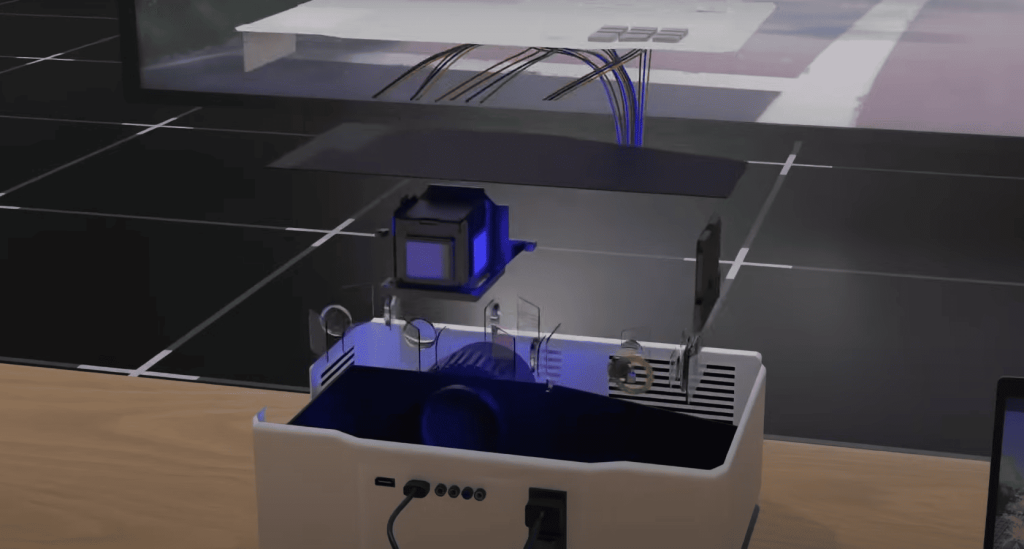
Control Panel
The control panel is where users can adjust various settings of the projector, such as brightness, contrast, and input sources. It typically includes buttons or a touchpad for navigation and menu selection. Some projectors may also come with remote controls for convenient operation, especially in larger rooms where accessing the control panel may not be possible.
Connectivity options
Projectors can receive signals from various devices, including laptops, DVD players, and gaming consoles. To facilitate this, most projectors offer multiple connectivity options such as HDMI, VGA, and USB ports. Higher-end projectors may also have wireless connectivity options, allowing for easier integration into a network or remote operation.
Setting Up a Projector
Now that we have covered the key components of a projector, let’s briefly go over the setup process. First, find an appropriate location to place the projector, ensuring enough space for proper ventilation and room for adjustments if needed. Next, connect your devices using the relevant cables or through wireless means. Finally, adjust the settings on the control panel or remote to achieve the desired image quality and size.
Maintenance and Care Tips
To ensure the longevity and optimal performance of your projector, regular maintenance is crucial. Here are some tips to keep in mind:
- Clean the lens regularly with a soft cloth to remove dust and smudges.
- Check for any dust buildup or obstructions in the cooling system and clean them if necessary.
- Replace the light source when it begins to dim or fails entirely.
- Store the projector in a cool and dry place when not in use.
- Follow the manufacturer’s instructions for any specific maintenance procedures.
How to Choose a Projector?
When looking to purchase a projector, consider the following factors:
- Purpose: Will the projector be used for business presentations, home entertainment, or both?
- Environment: Consider factors such as room size, lighting conditions, and desired image size.
- Resolution: Higher resolutions offer better image quality but come at a higher cost. Choose one that suits your needs.
- Connectivity Options: Make sure the projector has the necessary ports for your devices.
- Budget: Set a budget and compare prices and features of various projectors within that range. [3]
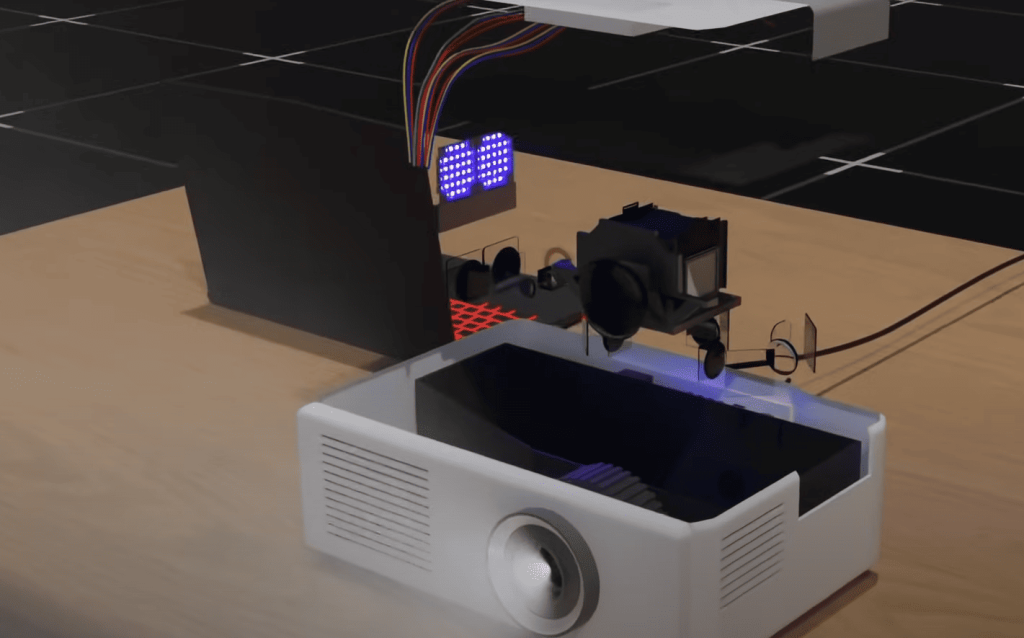
Types of Projectors
There are several types of projectors available on the market today, each with its unique features and uses. Some of the most common ones include:
- Pico Projectors: Small, portable projectors that can fit in your pocket.
- LCD Projectors: Use liquid crystal display technology to produce images.
- DLP Projectors: Use digital micromirror devices for image projection.
- Laser Projectors: Use laser light sources for better color accuracy and longer lifespan.
- 4K Projectors: Offer high-resolution images and are the go-to choice for home cinema enthusiasts.
How to Clean a Projector?
Proper maintenance and cleaning are essential for prolonging the life of your projector. Here are some steps to follow when cleaning your projector:
- Turn off and unplug the projector.
- Remove the lamp cover and gently clean it with a soft cloth or cotton swab.
- Clean any dust particles from the air filters using a vacuum cleaner or compressed air.
- Wipe down the exterior of the projector with a damp cloth.
- Clean the lens using a soft, lint-free cloth and gentle cleaning solution if needed.
- Allow all components to dry completely before reassembling and turning on the projector again. [4]
Where to Buy Projectors?
Projectors have become an essential tool for presentations, entertainment, and educational purposes. With advancements in technology, projectors are now available in various models and designs to cater to different needs. If you’re looking to invest in a projector, there are several options available in the market.
In this section, we’ll discuss some of the best places to buy projectors and what to consider before making your purchase.
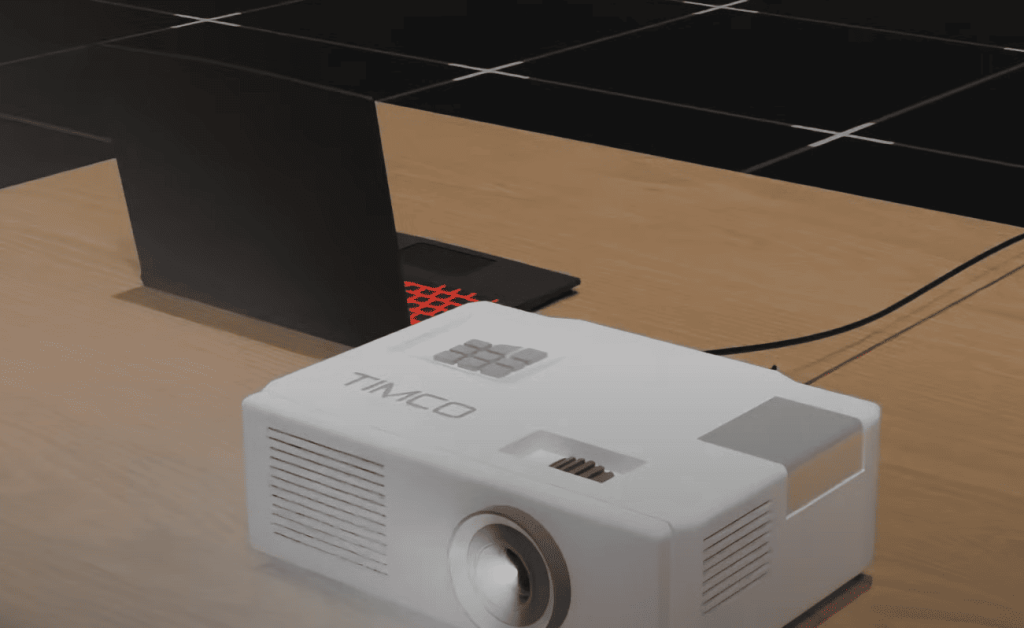
Online Retailers
Online retailers offer a plethora of options when it comes to buying projectors. Websites like Amazon, Best Buy, and Newegg have a wide selection of projectors from different brands and price ranges. Here are some advantages of purchasing projectors from online retailers:
- Convenience: You can browse through a variety of options from the comfort of your home, compare prices and features, and make a purchase without stepping out.
- Reviews: Online retailers have customer reviews for each product, which can help you gauge the performance and reliability of a particular projector.
- Discounts and Deals: These websites often offer discounts and deals on projectors, making them more affordable.
Physical Stores
If you prefer to physically see and test the projector before making a purchase, then physical stores are your best bet. Retailers like Best Buy, Walmart, and Target have projectors available for display and testing. Here’s why you should consider buying from a physical store:
- Hands-on Experience: You can check the image quality, brightness, sound, and other features of the projector in person before buying.
- Return and Exchange Policies: Physical stores often have more lenient return and exchange policies compared to online retailers, making it easier for you to replace a faulty projector or make changes if needed.
Manufacturer’s Website
If you have a specific brand in mind, then purchasing directly from the manufacturer’s website is an option worth considering. Here are some reasons to buy from the manufacturer’s website:
- Direct Support: If you have any queries or face any issues with your projector, you can directly contact the manufacturer for support.
- Warranty and Authenticity: Buying from the manufacturer ensures that you receive a genuine product and also helps in availing warranty services if needed. [5]

Considerations Before Buying
Before making a purchase, here are some factors to keep in mind:
- Budget: Projectors come in various price ranges, so it’s essential to determine your budget before starting your search.
- Purpose: Your intended use for the projector will help narrow down your options. For presentations and educational purposes, a basic model with decent image quality would suffice. However, for home entertainment or professional use, you may need a higher-end projector with advanced features.
- Brightness and Resolution: These two factors play a crucial role in the image quality of a projector. The brightness is measured in lumens, and the higher the number, the brighter the image will be. As for resolution, a higher resolution means sharper and more detailed images.
- Connectivity: Make sure to check if the projector has all the necessary ports and connections for your devices.
- Maintenance: Consider the maintenance costs of the projector, such as replacing bulbs or filters.
With these factors in mind, you can now confidently make an informed decision on where to buy your perfect projector. [6]
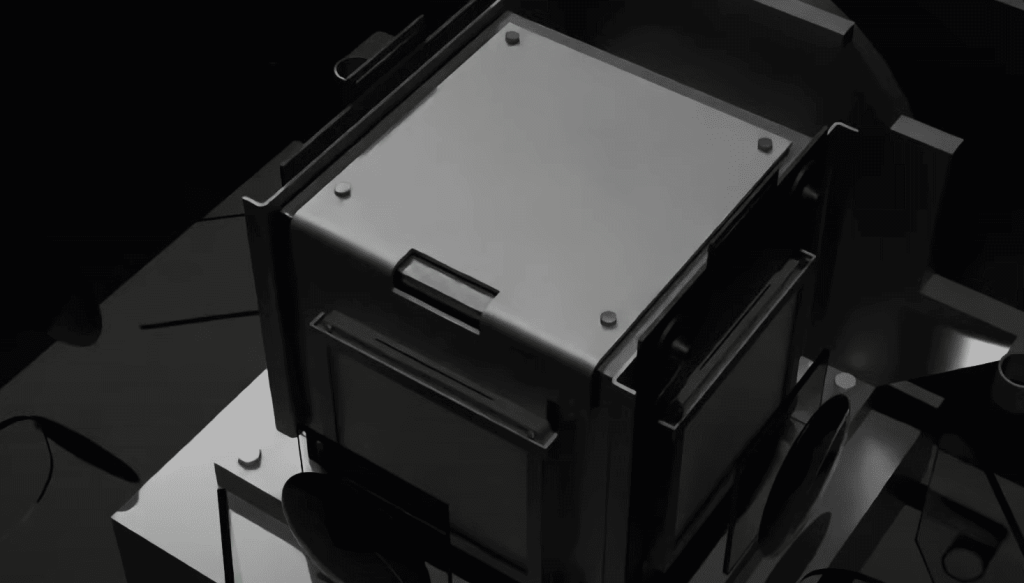
FAQs
What is a projector and what are its main uses?
A projector is an electronic device that projects light through a lens to display images or videos onto a screen, wall or other flat surface. It is commonly used in various settings such as classrooms, offices, and homes for presentations, movie screenings, gaming, and other visual displays.
What are the components of a projector?
The main components of a projector include the light source (lamp or LED), lens, imaging technology (LCD, DLP, or LCoS), and the projector body that houses these components. Some projectors may also include additional features such as built-in speakers, remote control, and connectivity options.
What are the different types of projectors?
There are several types of projectors available in the market including multimedia projectors, home theater projectors, portable projectors, and short-throw projectors. Each type has its own unique features and is designed for specific purposes.
How do I choose the right projector for my needs?
When choosing a projector, consider factors such as the brightness (measured in lumens), resolution (often represented by numbers such as 1080p or 4K), contrast ratio, and throw distance (how far the projector needs to be placed from the screen). You should also consider your intended usage and budget.
Can I connect my laptop or other devices to a projector?
Yes, most projectors come with different connectivity options such as HDMI, USB, and VGA ports that allow you to connect various devices. Some projectors also offer wireless connectivity options via Wi-Fi or Bluetooth.
Do projectors require maintenance?
Like any electronic device, projectors do require some maintenance. This may include regular cleaning of the lens and other components, replacing the lamp when it burns out (for lamp-based projectors), and updating firmware if necessary. Refer to your projector’s manual for specific maintenance instructions.
Are projectors suitable for outdoor use?
Some projectors are designed specifically for outdoor use and may have features such as weather-resistant housings and high brightness levels to overcome ambient lighting. However, not all projectors are suitable for outdoor use, so be sure to check the manufacturer’s specifications before using a projector outdoors.
How long do projectors typically last?
The lifespan of a projector depends on several factors such as the type of lamp or LED used, usage frequency, and maintenance. On average, a projector’s lifespan can range from 2,000 to 20,000 hours. It is important to follow proper maintenance procedures and replace parts when necessary to prolong the life of your projector.
Can I use my projector for gaming?
Yes, projectors can be used for gaming, but it is important to choose a projector with low input lag (the time it takes for the projector to process and display an image), high refresh rate, and adequate brightness. Gaming projectors may also have specialized features such as game mode settings and 3D capabilities.
Are there any safety precautions I should take when using a projector?
Yes, it is important to follow safety precautions when using a projector. This may include placing the projector on a stable surface, avoiding looking directly into the lens, and turning off the projector before unplugging or moving it. Refer to your projector’s manual for specific safety guidelines.
Where can I purchase a projector?
Projectors can be purchased from various electronic stores, online retailers, and directly from the manufacturer. It is important to research and compare prices, features, and warranties before making a purchase. Some manufacturers may also offer rental or lease options for short-term use of projectors.
How does a projector work?
A projector works by projecting light from a source (lamp or LED) through a lens onto a surface, using imaging technology to display images or videos. The light is focused and reflected off mirrors or other components within the projector to produce the desired image. The color and brightness of the projected image can be adjusted through settings on the projector. Projectors also often have built-in fans to keep the components cool and prevent overheating.
What are the advantages of using a projector in a classroom or business meeting?
Using a projector in a classroom or business meeting can have several advantages, including:
- Enhanced visual learning: Projectors allow for larger and clearer images to be displayed, making it easier for students or audience members to see and understand the information being presented.
- Improved collaboration: With the use of interactive projectors, group work and brainstorming sessions can be made more dynamic and engaging.
- Time-saving: Projectors can save time by allowing for quick and easy sharing of information or presentations without the need to print out physical copies.
- Cost-effective: Instead of using individual screens for each person, a single projector can display information to a larger audience at once, making it more cost-effective in the long run.
- Flexibility: Projectors are portable and can be easily set up in different locations, making them a versatile choice for various settings or events.
Are there different projectors for different needs (business, home, education)?
Yes, there are different types of projectors available for different needs such as business, home, and education. Business projectors may have features such as wireless connectivity and high brightness levels to accommodate larger meeting rooms. Home projectors may prioritize image quality and color accuracy for a more immersive viewing experience. Education projectors may have interactive capabilities and durable designs to withstand frequent use in classroom settings. It is important to consider your specific needs and usage when selecting a projector.
How to troubleshoot common projector issues?
Some common projector issues include distorted or flickering images, a blank screen, and problems with connectivity. Here are some general troubleshooting tips that may help resolve these issues:
- Check all connections: Make sure all cables are securely connected to both the projector and the device you are trying to connect.
- Adjust display settings: If the image appears distorted or stretched, try adjusting the display settings on your device.
- Clean the lens: A dirty lens can affect image quality, so regularly clean it with a soft cloth.
- Check for firmware updates: Make sure your projector’s firmware is up to date to ensure optimal performance.
What is the significance of the resolution in a projector?
Resolution refers to the number of pixels that make up an image on a display. In projectors, resolution determines the sharpness and clarity of the projected image. Higher resolutions (such as 1080p or 4K) will result in a clearer and more detailed image compared to lower resolutions (such as 480p). It is important to consider your intended use for the projector when choosing a resolution, as higher resolutions may come at a higher cost. However, with advances in technology and decreasing prices, higher resolutions are becoming more accessible in projectors.
Conclusion
In conclusion, projectors are an essential tool for presentations, entertainment, and education purposes. They have significantly evolved over the years, becoming more advanced and user-friendly. With a variety of components such as lenses, light sources, and image processors working together seamlessly, projectors can produce high-quality images and videos on a large screen.
There are various types of projectors available in the market, each with its unique features and specifications. Some are specifically designed for business presentations, while others are more suitable for home theaters for gaming purposes. It is essential to consider your specific needs and requirements when choosing a projector.
Additionally, projectors come in different sizes and prices, making it accessible for anyone to own one. They offer convenience and flexibility as they can be easily transported and set up in any location. With the advancement of technology, projectors are becoming more compact and portable, making them an ideal choice for individuals on-the-go.
In summary, projectors have come a long way from their initial bulky and expensive versions. They have become an integral part of our daily lives, enhancing our visual experience and making presentations more engaging and interactive. As technology continues to advance, we can only expect projectors to become even more advanced and efficient in the future. So, if you are looking for a versatile and high-quality display solution, consider investing in a projector.
How Projectors Work? (3D Animation)
References
- https://optics.fujifilm.com/projector/en/spec/manual/fp-z5000/about_this_product/parts/
- https://bestgamingprojector.com/blog/what-are-the-parts-of-a-projector/
- https://www.researchgate.net/figure/Main-components-A-Projection-screen-B-Main-projector-C-Still-camera-D-Video_fig2_221342487
- https://onsme.com/parts-of-a-projector/
- https://www.projectorscreen.com/blog/How-Does-A-LCD-Projector-Work
- https://allforturntables.com/2023/10/26/what-are-the-parts-of-a-projector/

